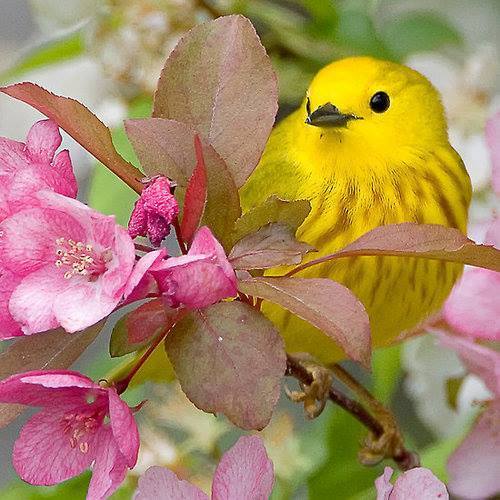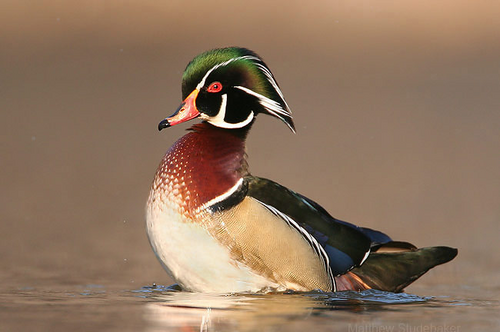It looks like you're using an Ad Blocker.
Please white-list or disable AboveTopSecret.com in your ad-blocking tool.
Thank you.
Some features of ATS will be disabled while you continue to use an ad-blocker.
15
share:
I thought I would share a bit of the bird life here in SA for those animal and nature lovers here on ATS.

African jacanas are conspicuous and unmistakable birds. They are about 30 cm long, but females are larger than males. They have chestnut upperparts with black wingtips, rear neck, and eyestripe. The underparts are also chestnut in the adults, only in juveniles they are white with a chestnut belly patch. The blue bill extends up as a coot-like head shield, and the legs and long toes are grey.
African jacanas feed on insects and other invertebrates picked from the floating vegetation or the surface of the water.

The saddle-billed stork is a large wading bird in the stork family, Ciconiidae. It is a widespread species which is a resident breeder in sub-Saharan Africa from Sudan, Ethiopia and Kenya south to South Africa, and in The Gambia, Senegal, Côte d'Ivoire and Chad in west Africa.
This is a huge bird that regularly attains a height of 150 cm (59 in), a length of 142 cm (56 in) and a 2.4–2.7 m (7.9–8.9 ft) wingspan. The male is larger and heavier than the female, with a range of 5.1–7.52 kg (11.2–16.6 lb), with a mean mass of 6.38 kg (14.1 lb). The female is usually between 5 and 6.84 kg (11.0 and 15.1 lb), with a mean mass of 5.95 kg (13.1 lb). It is probably the tallest of the storks (though not the heaviest), due in no small part to it extremely long legs (tarsus length is up to 36.5 cm (14.4 in)). The long bill measures from 27.3 to 36 cm (10.7 to 14.2 in). The sexes can be readily distinguished by the golden yellow irises of the female and the brown irises and dangling yellow wattles of the male.
They are silent except for bill-clattering at the nest. Like most storks, these fly with the neck outstretched, not retracted like a heron; in flight, the large heavy bill is kept drooping somewhat below belly height, giving these birds a very unusual appearance to those who see them for the first time. To experienced birdwatchers on the other hand, this makes them easily recognizable even if seen from a distance. It has been suggested that due to the large size and unusual appearance in flight, this species is the basis for the "big bird" and kongamato cryptids.
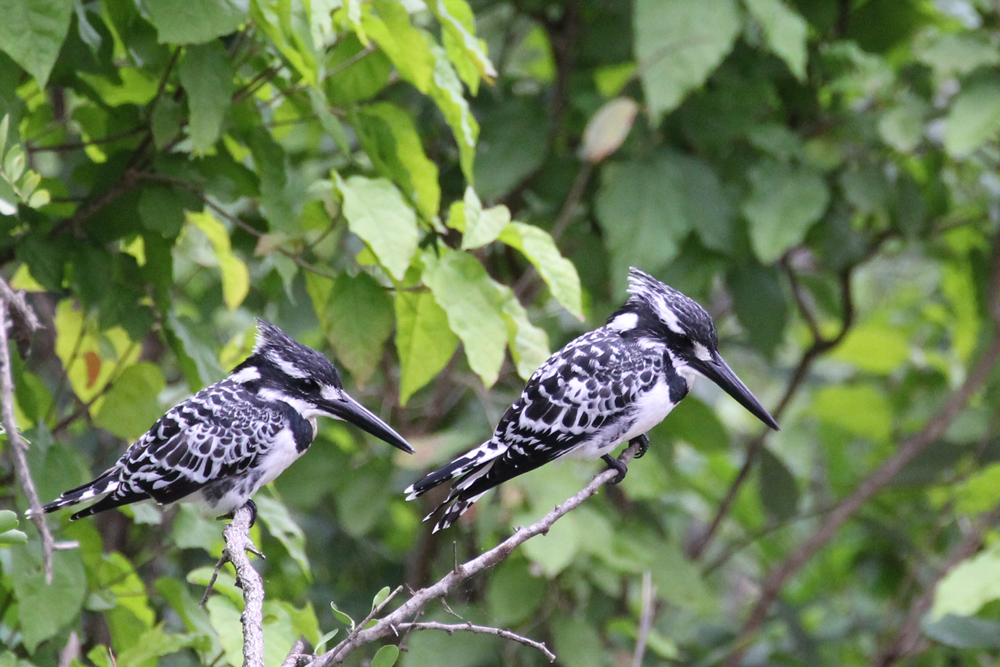
The pied kingfisher is a water kingfisher and is found widely distributed across Africa and Asia. Its black and white plumage, crest and the habit of hovering over clear lakes and rivers before diving for fish makes it distinctive. Males have a double band across the breast while females have a single gorget that is often broken in the middle. They are usually found in pairs or small family parties. When perched, they often bob their head and flick up their tail.
This kingfisher is about 17 cm long and is white with a black mask, a white supercilium and black breast bands. The crest is neat and the upperparts are barred in black. Several subspecies are recognized within the broad distribution. The nominate race is found in sub-Saharan Africa, extending into West Asia. A former subspecies syriaca is considered as merely a larger northern bird of the nominate species (following Bergmann's rule). Subspecies leucomelanura is found from Afghanistan east into India, Sri Lanka, Thailand and Laos. The subspecies travancoreensis of the Western Ghats is darker with the white reduced. Subspecies C. r. insignis is found in Hainan and southeastern China and has a much larger bill. Males have a narrow second breast-band while females have a single broken breast band.
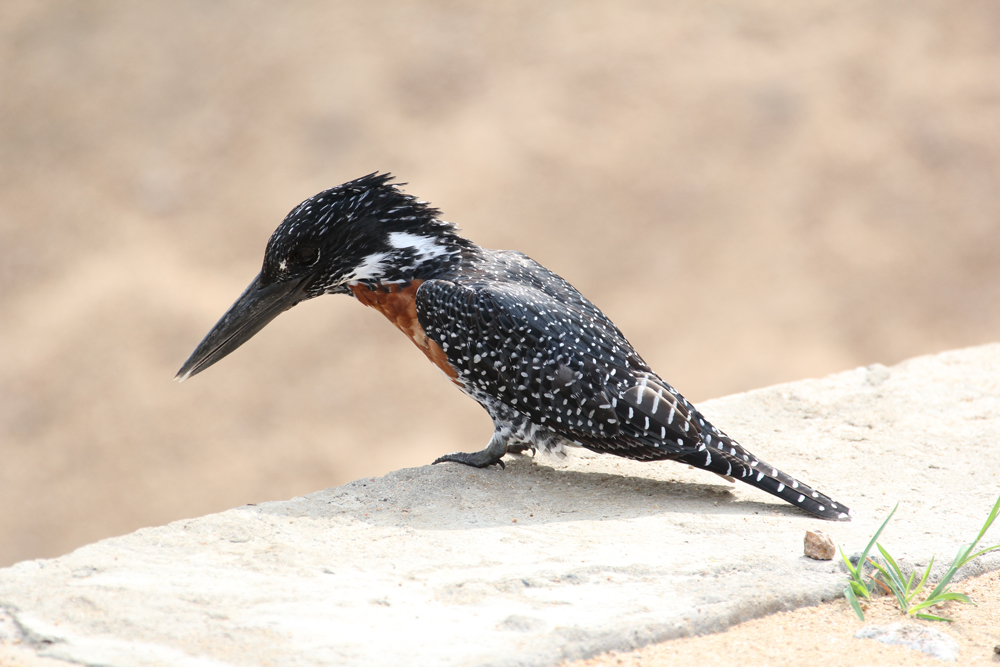
The giant kingfisher is the largest kingfisher in Africa, where it is a resident breeding bird over most of the continent south of the Sahara Desert other than the arid southwest.
The giant kingfisher is 42–48 cm (16½-18⅞ inches) long, with a large crest and finely spotted white on black upperparts. The male has a chestnut breast band and otherwise white underparts with dark flank barring, and the female has a white-spotted black breast band and chestnut belly.
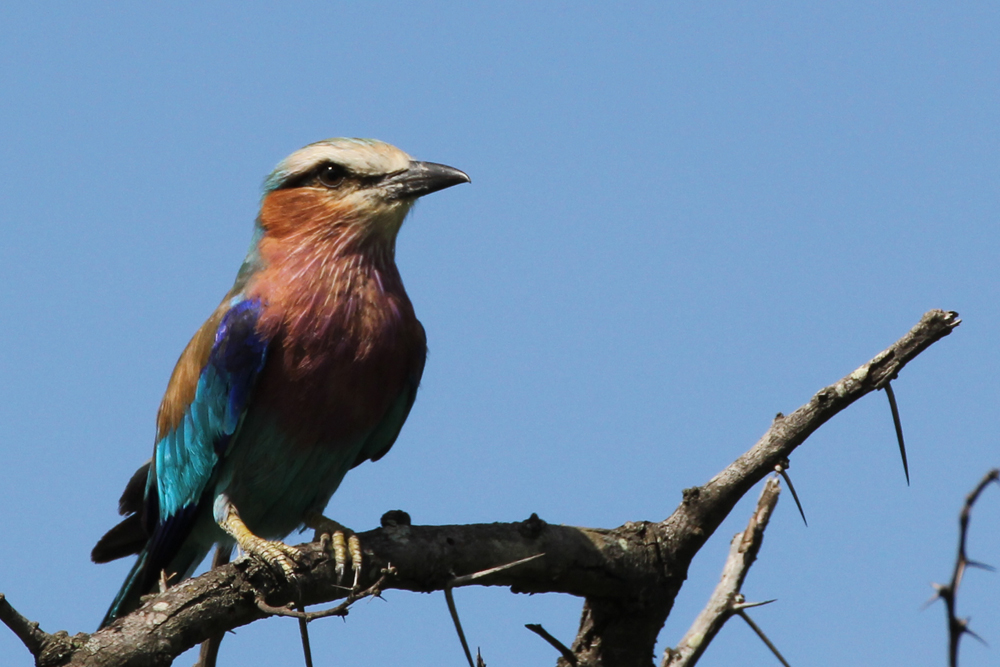
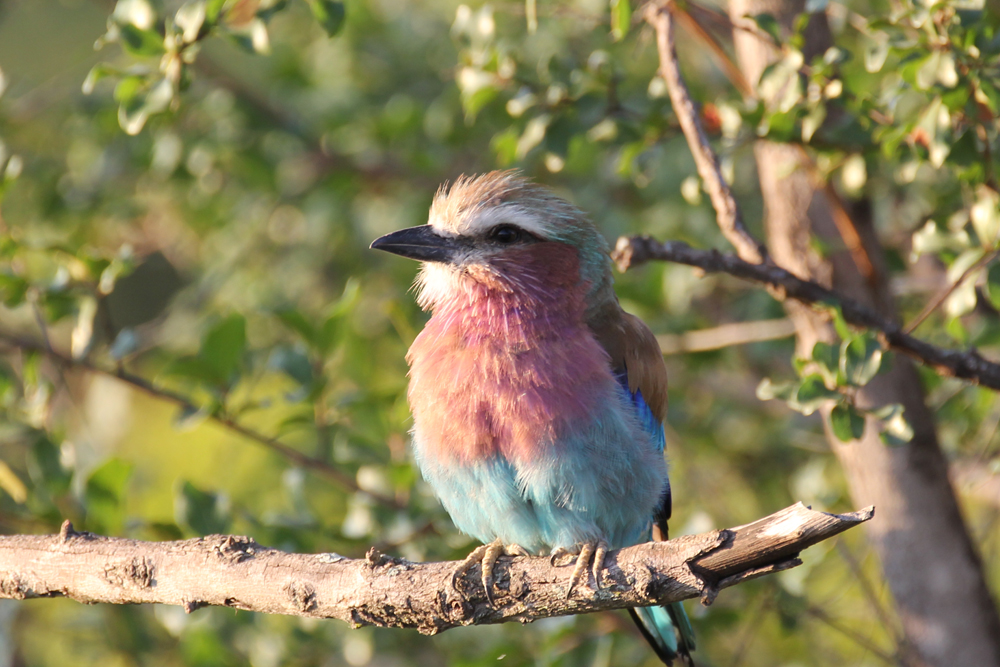
The lilac-breasted roller is a member of the roller family of birds. It is widely distributed in sub-Saharan Africa and the southern Arabian Peninsula, preferring open woodland and savanna; it is largely absent from treeless places.
The average size of the Lilac Breasted Roller is 14.5 inches. The washed green head is large, the neck is short, the greenish yellow legs are rather short and the feet are small. The beak is strong, arched and hooked-tipped. The tail is narrow and of medium length. The back and scapulars are brown. The shoulder of the wing, outer webs of the flight feathers and the rump are all violet. The bases of the primaries and their coverts are pale greenish blue and the outer tail feathers are elongated and blackish. The chin is whitish, shading to rich lilac of the breast. The underparts are greenish blue. The bill is black and the eyes are brown. It has large wings and strong flight.
Usually found alone or in pairs, it perches conspicuously at the tops of trees, poles or other high vantage points from where it can spot insects, lizards, scorpions, snails, small birds and rodents moving about at ground level. Nesting takes place in a natural hole in a tree where a clutch of 2–4 eggs is laid, and incubated by both parents, who are extremely aggressive in defence of their nest, taking on raptors and other birds. During the breeding season the male will rise to great heights, descending in swoops and dives, while uttering harsh, discordant cries.

The African green pigeon is a species of bird in the Columbidae family, and one of 5 green pigeon species in the Afrotropics. As with others in their genus, they frequent tree canopies where their parrot-like climbing ability enable them to reach fruit, but rarely also forage on the ground. The species has a wide range in Sub-Saharan Africa with around 17 accepted races.
Adult birds have maroon shoulder patches (olive in immatures) and rufous undertail coverts. They reach a length of 25–28 cm. Their call is a series of flowing whistles, rendered as ‘thweeeloo, thweeeoo’. They inhabit riparian forest, woodland and savanna, where they associate with fruiting trees, especially wild fig (Ficus) species, including Ficus sycomorus and Ficus sur, and in cities the ornamental Chinese banyan. They also take fruit of Saffrons (Cassine spp.), Jacket plum (Pappea capensis), Buffalo thorn (Ziziphus mucronata), Water berry (Syzygium cordatum) and Jackalberry (Diospyros mespiliformis). They may also feed on exotic Loquats and Mulberries, or on carrion by occasion.
Their upperparts are greyish green to yellowish green, their thighs are yellow with mauve patches on the top of the wing. The green plumage provides a great camouflage in the tops of trees. Their bills are red at the base white at the tip. Their feet are also red.

African jacanas are conspicuous and unmistakable birds. They are about 30 cm long, but females are larger than males. They have chestnut upperparts with black wingtips, rear neck, and eyestripe. The underparts are also chestnut in the adults, only in juveniles they are white with a chestnut belly patch. The blue bill extends up as a coot-like head shield, and the legs and long toes are grey.
African jacanas feed on insects and other invertebrates picked from the floating vegetation or the surface of the water.

The saddle-billed stork is a large wading bird in the stork family, Ciconiidae. It is a widespread species which is a resident breeder in sub-Saharan Africa from Sudan, Ethiopia and Kenya south to South Africa, and in The Gambia, Senegal, Côte d'Ivoire and Chad in west Africa.
This is a huge bird that regularly attains a height of 150 cm (59 in), a length of 142 cm (56 in) and a 2.4–2.7 m (7.9–8.9 ft) wingspan. The male is larger and heavier than the female, with a range of 5.1–7.52 kg (11.2–16.6 lb), with a mean mass of 6.38 kg (14.1 lb). The female is usually between 5 and 6.84 kg (11.0 and 15.1 lb), with a mean mass of 5.95 kg (13.1 lb). It is probably the tallest of the storks (though not the heaviest), due in no small part to it extremely long legs (tarsus length is up to 36.5 cm (14.4 in)). The long bill measures from 27.3 to 36 cm (10.7 to 14.2 in). The sexes can be readily distinguished by the golden yellow irises of the female and the brown irises and dangling yellow wattles of the male.
They are silent except for bill-clattering at the nest. Like most storks, these fly with the neck outstretched, not retracted like a heron; in flight, the large heavy bill is kept drooping somewhat below belly height, giving these birds a very unusual appearance to those who see them for the first time. To experienced birdwatchers on the other hand, this makes them easily recognizable even if seen from a distance. It has been suggested that due to the large size and unusual appearance in flight, this species is the basis for the "big bird" and kongamato cryptids.

The pied kingfisher is a water kingfisher and is found widely distributed across Africa and Asia. Its black and white plumage, crest and the habit of hovering over clear lakes and rivers before diving for fish makes it distinctive. Males have a double band across the breast while females have a single gorget that is often broken in the middle. They are usually found in pairs or small family parties. When perched, they often bob their head and flick up their tail.
This kingfisher is about 17 cm long and is white with a black mask, a white supercilium and black breast bands. The crest is neat and the upperparts are barred in black. Several subspecies are recognized within the broad distribution. The nominate race is found in sub-Saharan Africa, extending into West Asia. A former subspecies syriaca is considered as merely a larger northern bird of the nominate species (following Bergmann's rule). Subspecies leucomelanura is found from Afghanistan east into India, Sri Lanka, Thailand and Laos. The subspecies travancoreensis of the Western Ghats is darker with the white reduced. Subspecies C. r. insignis is found in Hainan and southeastern China and has a much larger bill. Males have a narrow second breast-band while females have a single broken breast band.

The giant kingfisher is the largest kingfisher in Africa, where it is a resident breeding bird over most of the continent south of the Sahara Desert other than the arid southwest.
The giant kingfisher is 42–48 cm (16½-18⅞ inches) long, with a large crest and finely spotted white on black upperparts. The male has a chestnut breast band and otherwise white underparts with dark flank barring, and the female has a white-spotted black breast band and chestnut belly.


The lilac-breasted roller is a member of the roller family of birds. It is widely distributed in sub-Saharan Africa and the southern Arabian Peninsula, preferring open woodland and savanna; it is largely absent from treeless places.
The average size of the Lilac Breasted Roller is 14.5 inches. The washed green head is large, the neck is short, the greenish yellow legs are rather short and the feet are small. The beak is strong, arched and hooked-tipped. The tail is narrow and of medium length. The back and scapulars are brown. The shoulder of the wing, outer webs of the flight feathers and the rump are all violet. The bases of the primaries and their coverts are pale greenish blue and the outer tail feathers are elongated and blackish. The chin is whitish, shading to rich lilac of the breast. The underparts are greenish blue. The bill is black and the eyes are brown. It has large wings and strong flight.
Usually found alone or in pairs, it perches conspicuously at the tops of trees, poles or other high vantage points from where it can spot insects, lizards, scorpions, snails, small birds and rodents moving about at ground level. Nesting takes place in a natural hole in a tree where a clutch of 2–4 eggs is laid, and incubated by both parents, who are extremely aggressive in defence of their nest, taking on raptors and other birds. During the breeding season the male will rise to great heights, descending in swoops and dives, while uttering harsh, discordant cries.

The African green pigeon is a species of bird in the Columbidae family, and one of 5 green pigeon species in the Afrotropics. As with others in their genus, they frequent tree canopies where their parrot-like climbing ability enable them to reach fruit, but rarely also forage on the ground. The species has a wide range in Sub-Saharan Africa with around 17 accepted races.
Adult birds have maroon shoulder patches (olive in immatures) and rufous undertail coverts. They reach a length of 25–28 cm. Their call is a series of flowing whistles, rendered as ‘thweeeloo, thweeeoo’. They inhabit riparian forest, woodland and savanna, where they associate with fruiting trees, especially wild fig (Ficus) species, including Ficus sycomorus and Ficus sur, and in cities the ornamental Chinese banyan. They also take fruit of Saffrons (Cassine spp.), Jacket plum (Pappea capensis), Buffalo thorn (Ziziphus mucronata), Water berry (Syzygium cordatum) and Jackalberry (Diospyros mespiliformis). They may also feed on exotic Loquats and Mulberries, or on carrion by occasion.
Their upperparts are greyish green to yellowish green, their thighs are yellow with mauve patches on the top of the wing. The green plumage provides a great camouflage in the tops of trees. Their bills are red at the base white at the tip. Their feet are also red.
Beautiful!
One of the things that always got to me is how you could sometimes see peacocks just kinda walking along side the houses, i remember distinctly seeing them in fourways a few times, not as remarkable as the ones you posted, but cool all the same! when i get home i might add a few pictures of the ones i spotted while living in SA, if i can find them of course, the sights are so beautiful i ended up with a 8Gb folder in the 3 years i was there
One of the things that always got to me is how you could sometimes see peacocks just kinda walking along side the houses, i remember distinctly seeing them in fourways a few times, not as remarkable as the ones you posted, but cool all the same! when i get home i might add a few pictures of the ones i spotted while living in SA, if i can find them of course, the sights are so beautiful i ended up with a 8Gb folder in the 3 years i was there
a reply to: IndependentOpinion
Beautiful! Thanks for sharing, S&F!
Some birds from here in Canada:
The Yellow Warbler
The Blue Jay
The Wood Duck
Beautiful! Thanks for sharing, S&F!
Some birds from here in Canada:
The Yellow Warbler
The Blue Jay
The Wood Duck
a reply to: IndependentOpinion
Thanks for sharing those. I especially love the Kingfisher shots, as I spend many hours sitting watching the Common Kingfishers in my local area (spread over a radius of about 20 miles). I am lucky to have many lakes, reservoirs and rivers nearby that provide the ideal habitat for them.
Here's a shot of the local female on the moor at the edge of town.
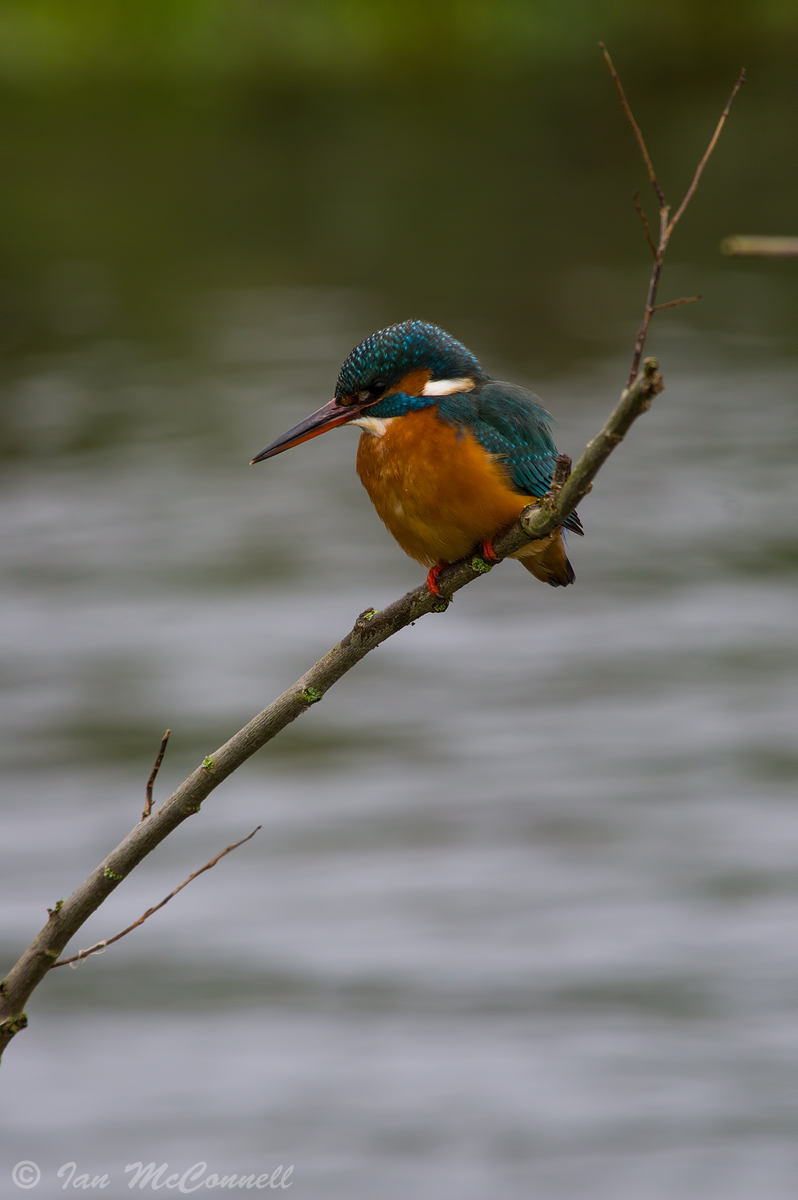
Being a nature lover, most weekends I am out at my usual spot watching and photographing whatever comes my way. I've recently had some great close encounters with a male American Mink and managed to get some good close shots of him. Here's one from last month, my favourite shot of the year so far.

Looking forward now to Spring / Summer and all the wildflowers and insects, especially the Dragonflies and Butterflies.
Thanks for sharing those. I especially love the Kingfisher shots, as I spend many hours sitting watching the Common Kingfishers in my local area (spread over a radius of about 20 miles). I am lucky to have many lakes, reservoirs and rivers nearby that provide the ideal habitat for them.
Here's a shot of the local female on the moor at the edge of town.

Being a nature lover, most weekends I am out at my usual spot watching and photographing whatever comes my way. I've recently had some great close encounters with a male American Mink and managed to get some good close shots of him. Here's one from last month, my favourite shot of the year so far.

Looking forward now to Spring / Summer and all the wildflowers and insects, especially the Dragonflies and Butterflies.
Thanks for the images. Nice thread!
Found this HD clip of a kingfisher:
Found this HD clip of a kingfisher:
edit on 26-2-2015 by ColeYounger because: (no reason given)
a reply to: ColeYounger
I can sit there all day watching these little beauties fishing.
At my usual spot, they often sit fishing right in front as me as I am usually well hidden and quiet. Last year they had 2 broods, so was great watching the youngsters practicing too.
I can sit there all day watching these little beauties fishing.
At my usual spot, they often sit fishing right in front as me as I am usually well hidden and quiet. Last year they had 2 broods, so was great watching the youngsters practicing too.
originally posted by: IndependentOpinion
a reply to: Britguy
What an amazing experiance that must have been!!!!
It's always a great experience. I always have my little buddy, a Robin, come and sit with me and I hand feed him too. It's very calming and a great escape from the problems of the world for a while!
originally posted by: IShotMyLastMuse
Beautiful!
One of the things that always got to me is how you could sometimes see peacocks just kinda walking along side the houses, i remember distinctly seeing them in fourways a few times, not as remarkable as the ones you posted, but cool all the same! when i get home i might add a few pictures of the ones i spotted while living in SA, if i can find them of course, the sights are so beautiful i ended up with a 8Gb folder in the 3 years i was there
Peacocks? Oh you mean the Indigenous South African Goliath Peacock.... they feed on hippos and the occasional tokolosh.
a reply to: IndependentOpinion
They are beautiful birds though.
Lucky to have such impressive wildlife, all round
They are beautiful birds though.
Lucky to have such impressive wildlife, all round
new topics
-
Has Russia Tested its Hunter Killer Satellite again ?
World War Three: 1 hours ago -
Trying to improve my attention span and focus
General Chit Chat: 7 hours ago -
What Changed
2024 Elections: 7 hours ago -
Loud storm, loud magnets
The Gray Area: 8 hours ago -
Dr. Phil's One On One Interview With Robert F. Kennedy Jr.
Politicians & People: 9 hours ago -
Hypothetical Question - 2024 Elections
US Political Madness: 9 hours ago
top topics
-
Hey Lefties, can we talk about this yet?
US Political Madness: 14 hours ago, 20 flags -
What Changed
2024 Elections: 7 hours ago, 12 flags -
Dr. Phil's One On One Interview With Robert F. Kennedy Jr.
Politicians & People: 9 hours ago, 10 flags -
Trying to improve my attention span and focus
General Chit Chat: 7 hours ago, 9 flags -
Loud storm, loud magnets
The Gray Area: 8 hours ago, 8 flags -
Martin Mull dead at 80.
People: 14 hours ago, 7 flags -
Hypothetical Question - 2024 Elections
US Political Madness: 9 hours ago, 5 flags -
Has Russia Tested its Hunter Killer Satellite again ?
World War Three: 1 hours ago, 2 flags
active topics
-
June 27 Presidential Debate livestream
2024 Elections • 927 • : Zanti Misfit -
Has Russia Tested its Hunter Killer Satellite again ?
World War Three • 8 • : Bluntone22 -
Trying to improve my attention span and focus
General Chit Chat • 17 • : andy06shake -
Hey Lefties, can we talk about this yet?
US Political Madness • 106 • : asabuvsobelow -
What Changed
2024 Elections • 32 • : Dalamax -
SCOTUS just overturned Chevron deference, GUTTING three-letter agencies
US Political Madness • 55 • : boatguy12 -
1955 Flying Saucer shot down by RED WING pilots over The Bull of the Woods central Oregon
Aliens and UFOs • 62 • : bluemooone44 -
Loud storm, loud magnets
The Gray Area • 27 • : Daniidoom -
A challenge to Climate Change believers
Fragile Earth • 107 • : network dude -
Russia Suffers 'Highest Monthly' Losses Since War Began
World War Three • 124 • : Vermilion
15

